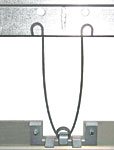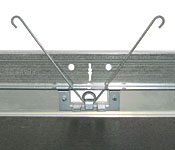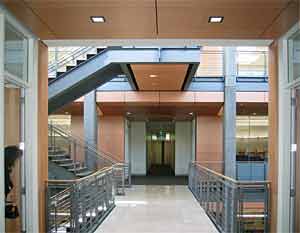Perforated Metal and Wood Ceilings: Sustainability, Acoustics, and Aesthetics
This has changed, however, with the development of wood panels with wood architectural veneers laminated to lightweight cores of sheet aluminum. Until recently, it has been difficult to get enough adhesion between wood and aluminum to meet the challenges of architectural service. This problem has been overcome through the use of new adhesives and a substrate pretreatment that changes the molecular texture of the aluminum sheet for improved tenacity. Aluminum cores, unlike typical wood and particle board cores, are non-combustible, will not support mold, and do not warp when exposed to changes in humidity. This last point means that construction schedules can be accelerated by installing panels before HVAC conditions in a building are stabilized.
|
|||||
The new wood-metal hybrid panels can be fabricated on the same machinery used to perforate and shape metal panels. The result is real wood panels that weigh as little as one pound per square foot, a fraction of the weight of panels with conventional wood cores. Their light weight makes them easy to handle and install, reduces the cost of the substructure from which a ceiling is suspended, and makes it possible to use wood ceilings in remodeling projects where the existing structure could not carry the weight of conventional wood panels. While the weight of conventional wood panels typically requires them to be mounted permanently in place, hybrid panels can be mounted with torsion springs or other simple connections that allow panels to snap into place and to be removed as required for convenient access above a ceiling. The new type of perforated wood panels also display the same high acoustical performance and design flexibility as metal panels.
Wood panels can provide high acoustical performance and design flexibility.
Despite these innovations, new wood panels still meet the quality standards of traditional architectural woodwork. For example, veneers have different grain characteristics depending upon whether they are plain sliced or rotary, quarter, or rift cut. Different visual effects can also be achieved by specifying the panels to have book, slip or random matched leaves of veneer. In addition to use on ceilings, these new wood panels are increasingly used on walls for wood paneling.
|
Going beyond tradition, however, the wood-metal hybrid panels offer superior sustainable qualities, such as finishes with zero volatile organic compounds (VOCs) and, when specified, veneers from sustainable forests or rapidly-renewable sources, in addition to the recycled content of their aluminum cores. And while urea formaldehyde, considered a "probable human carcinogen" by the Environmental Protection Agency, is still used in many conventional wood products, the new wood panels have no added formaldehyde.












